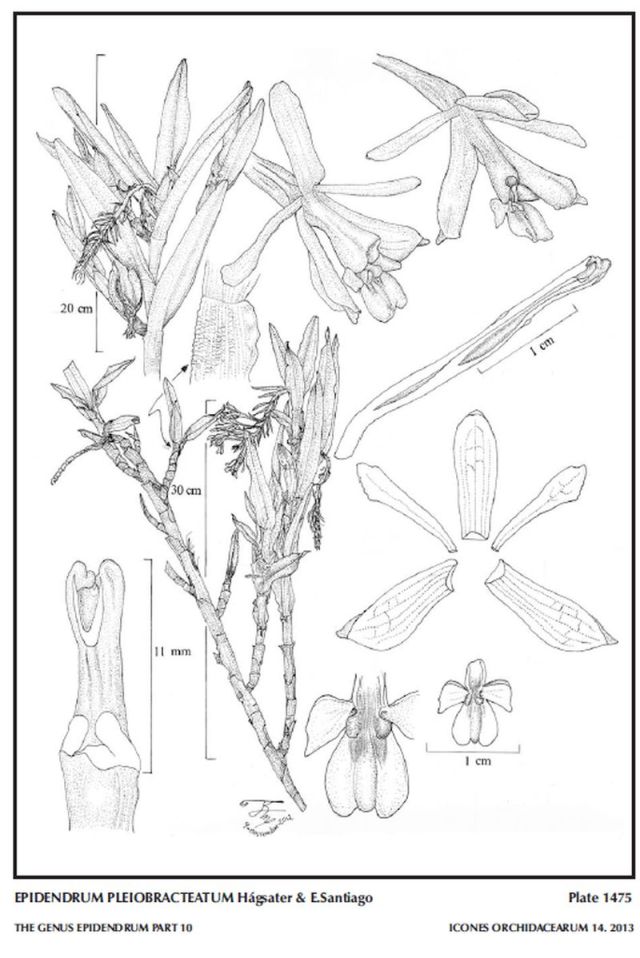

Epidendrum pleiobracteatum Hágsater & E.Santiago 2013 GROUP Andean SUBGROUP Fritzianum
TYPE Drawing by © Jimenez and The AMO Herbaria Website

 LATER
LATER 
Common Name The Many Bracted Epidendrum [refers to the numerous, congested, long floral bracts]
Flower Size 1.2” [3 cm]
Found in southwestern Colombia on the Cordillera Occidental at elevations of 3350 to 3450 meters as a giant sized, cold growing terrestrial with many branches throughout stems, cane-like, terete, erete, straight stems with a main, a secondary and a tertiary and these may branch as well stems carrying numerous on the main stem, 5 to 6 on the branches, all towards the apical half of the stem, alternate, articulate, sub-erect, unequal in size, the basal ones smaller, green to purplish green, lanceolate, acute, margin crenulate towards the apex leaves that blooms in the fall on a terminal, without a spathe, racemose, rarely producing an additional very short raceme at the apex of the peduncle, flowering only once, peduncle .6” [1.5 cm] long, terete, thin, short, provided at the apex with a bract 1.04” [26 mm] long, lanceolate, acuminate, amplexicaul, similar to the floral bracts but larger bracts, smultaneously 35 to 45 flowered inflorescence with prominent, shorter than the ovary, gradually shorter towards the apex of the rachis, narrowly triangular-lanceolate, acuminate, amplexicaul floral bracts and carrying resupinate, olive green flowers.
"Epidendrum pleiobracteatum belongs to the GROUP Andean SUBGROUP Fritzianum characterized by the cane-like stems with sub-apical branching, leaves membranaceous, acute-acuminate, the adpressed leaf sheaths, and entire or 3-lobed lip. The species is recognized by its tall plants, many-branched stems, lanceolate, acute leaves (those on the main stem larger), racemose, dense inflorescence with many ochraceous-green flowers, very prominent, closely-spaced floral bracts, sepals .56 to .2" [14 x 5 mm], the lateral lobes of the lip obliquely ovate and the mid-lobe obcordiform, widely emarginate. Epidendrum angeloglossum Hágsater & Dodson from northern Ecuador has shorter plants, successive, apple-green flowers on a shorter inflorescence, small floral bracts, the mid-lobe of the lip orbicular, the apex rounded, not emarginate, and the disc of the lip with multiple thickened veins throughout. Epidendrum chrysomyristicum Hágsater & E.Santiago from Bolivia and southern Peru, is vegetatively very similar, but the inflorescences are very short, few-flowered, with the floral bracts much shorter, the flowers yellow, the lateral lobes of the lip obliquely rectangular and mid-lobe “T”-shaped. Epidendrum lima Lindl. has lanceolate to ovate-lanceolate, short-acuminate leaves, a lax, few-flowered inflorescence with 5 to 12 successive, pale green to yellowish flowers, the lateral lobes transversely elliptic, and mid-lobe with an isthmus at the base and nonemarginate apex. Epidendrum trachychlaena Schltr. has elliptic, acuminate leaves, a paniculate, lax, few-flowered inflorescence, sepals .64 to .72" [16-18 mm] long; the lateral lobes of the lip are elliptic, acute, and the mid-lobe obcuneate. Epidendrum putidocardiophyllum Hágsater & Dodson has shorter plants, up to 24" [60 cm] tall, elliptic to lanceolate, shorter leaves .2 to 2.52" (0.5 to 6.3 cm long), inflorescence fewer flowered (ca. 23 flowers), lateral lobes of the lip very small, obliquely triangular, and the mid-lobe rectangular." Hagsater etal 2017
Synonyms
References W3 Tropicos, Kew Monocot list , IPNI ; * Icones Orchidacearum 14 Plate 1475 Hagsater & Santiago 2013 drawing fide; Orchids of the Department of Valle de Cauca Colombia Vol 2 Kolanowska, Hagsater, Ayala and Saldana 2014 drawing fide; Orquideas, Tesoro de Colombia Vol 2 Ortiz & Uribe 2017;
--------------------------------------------------------------------------------------------------------------------------